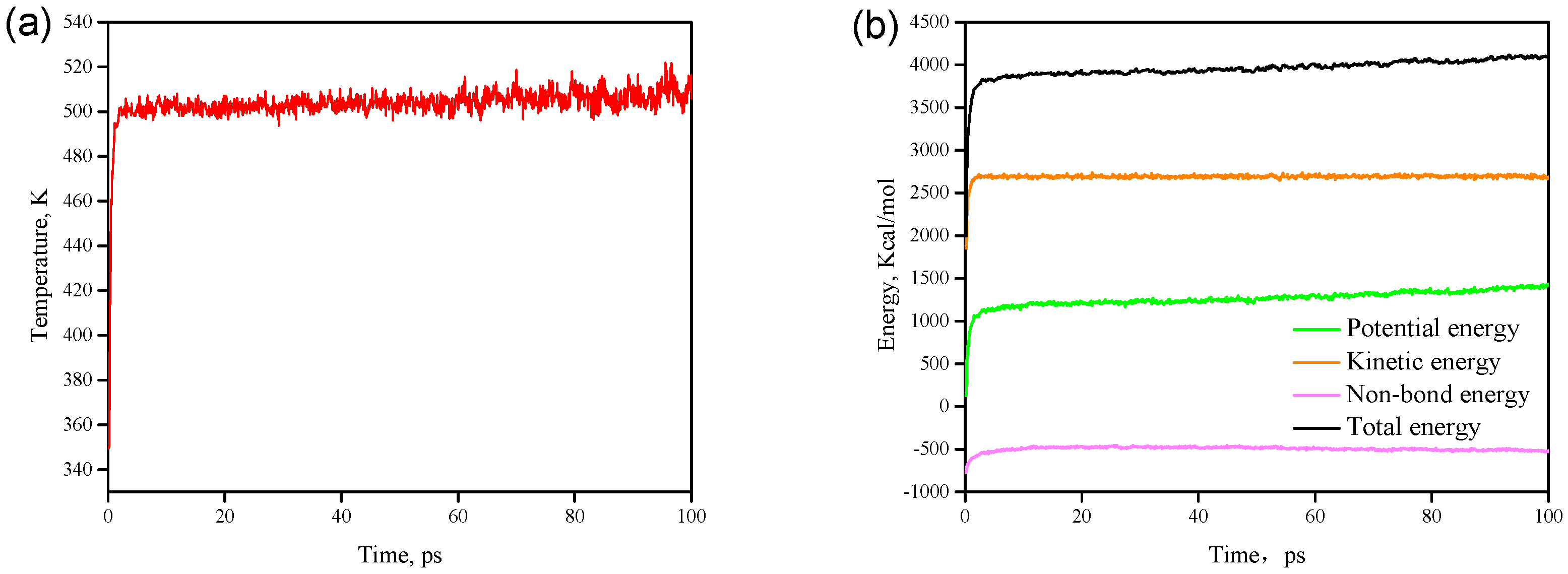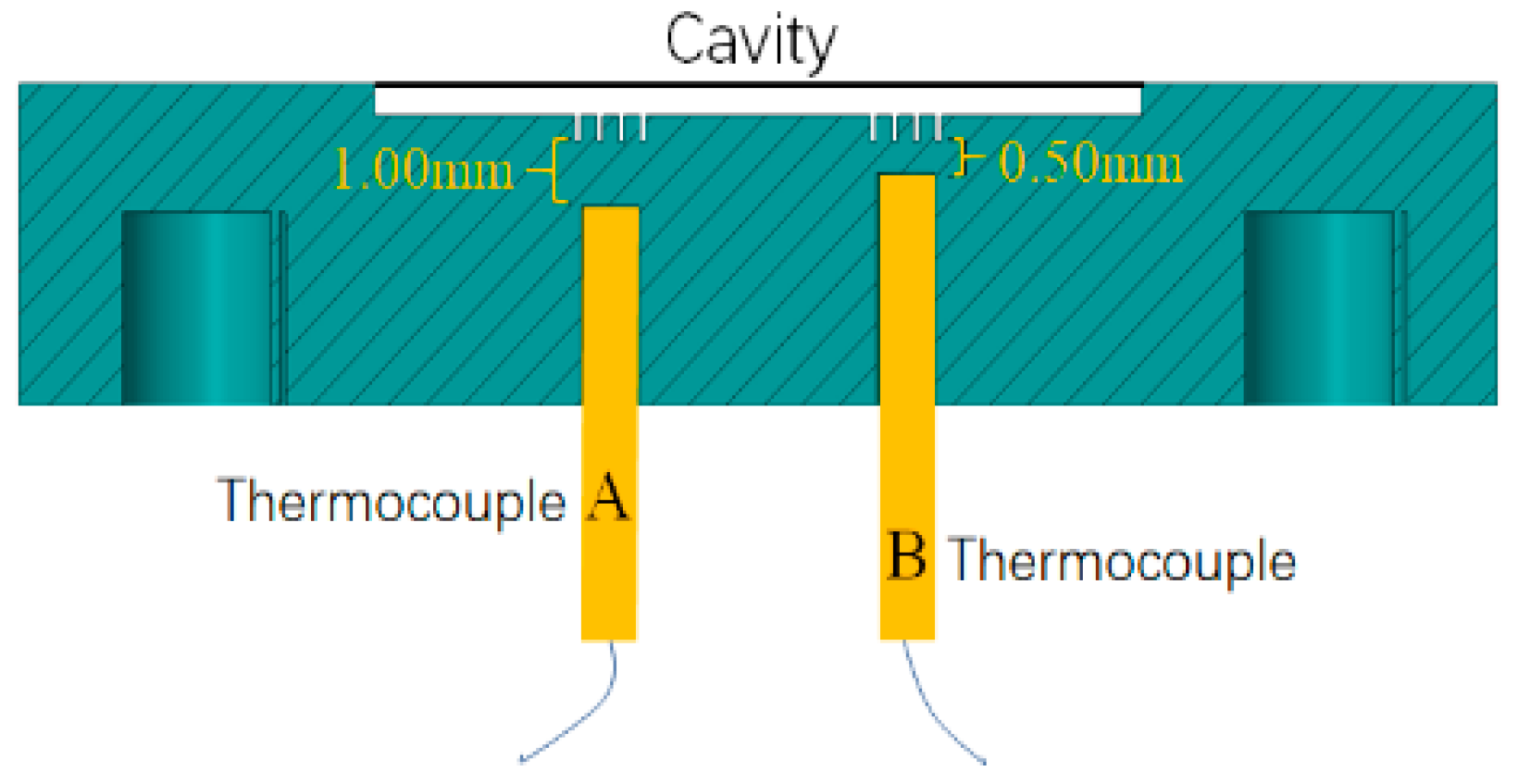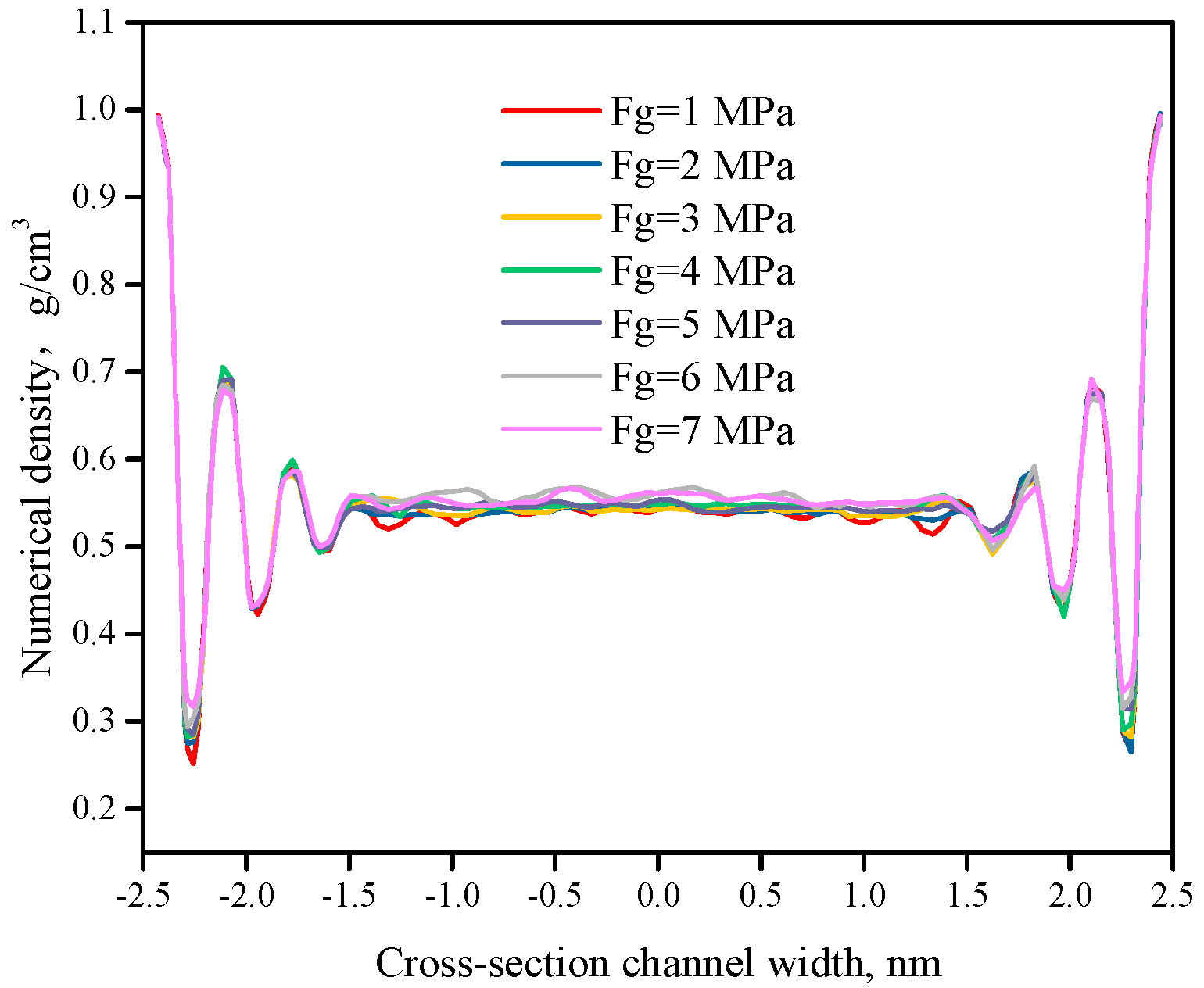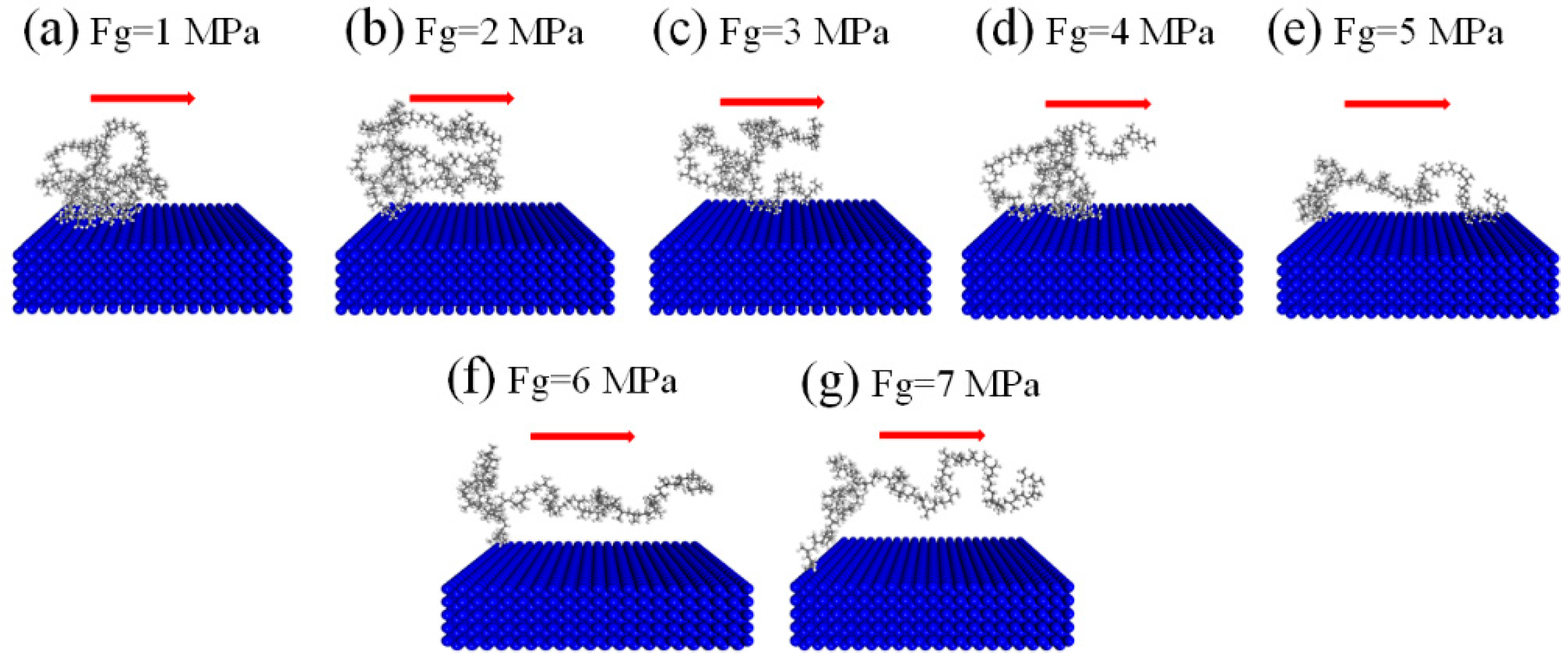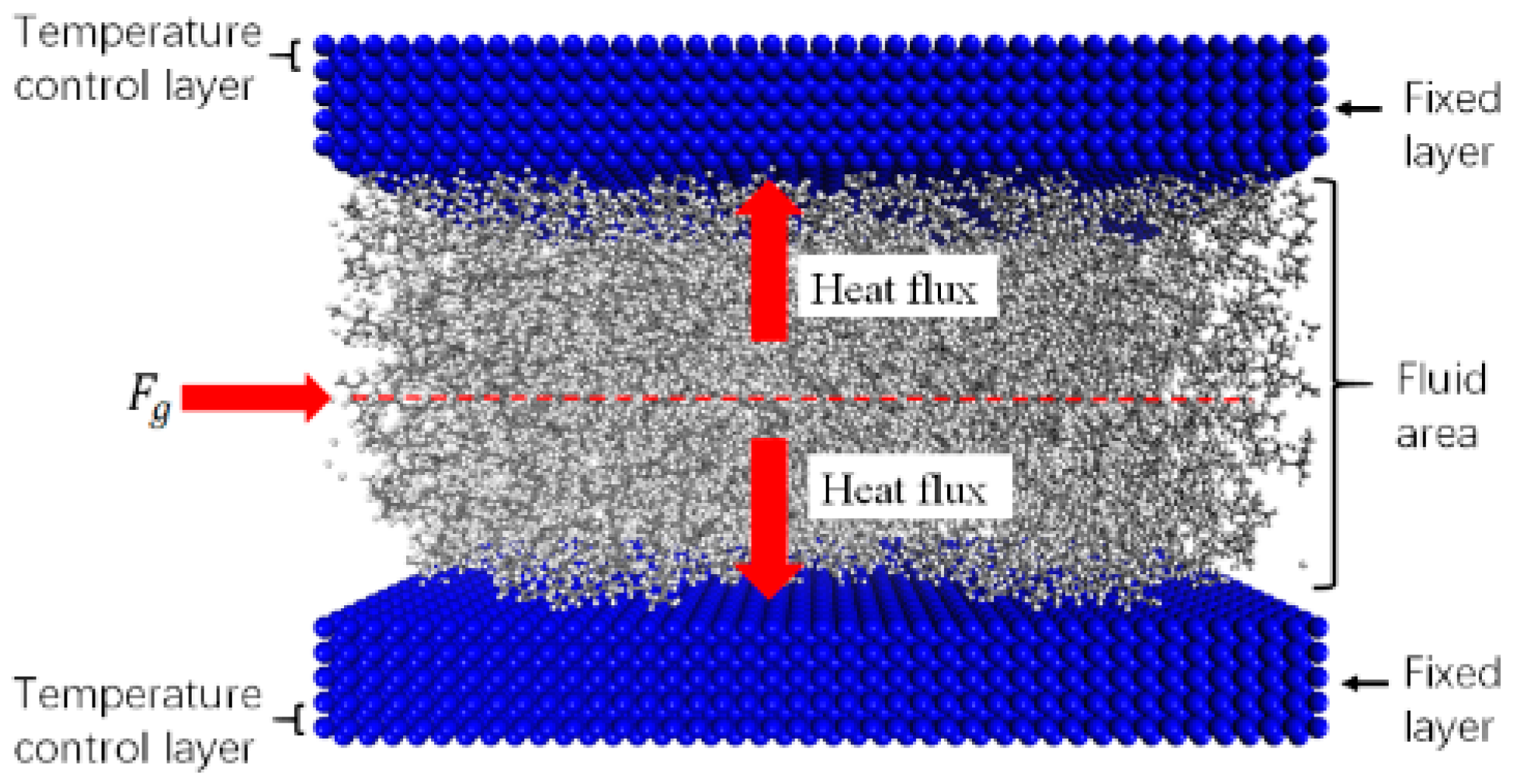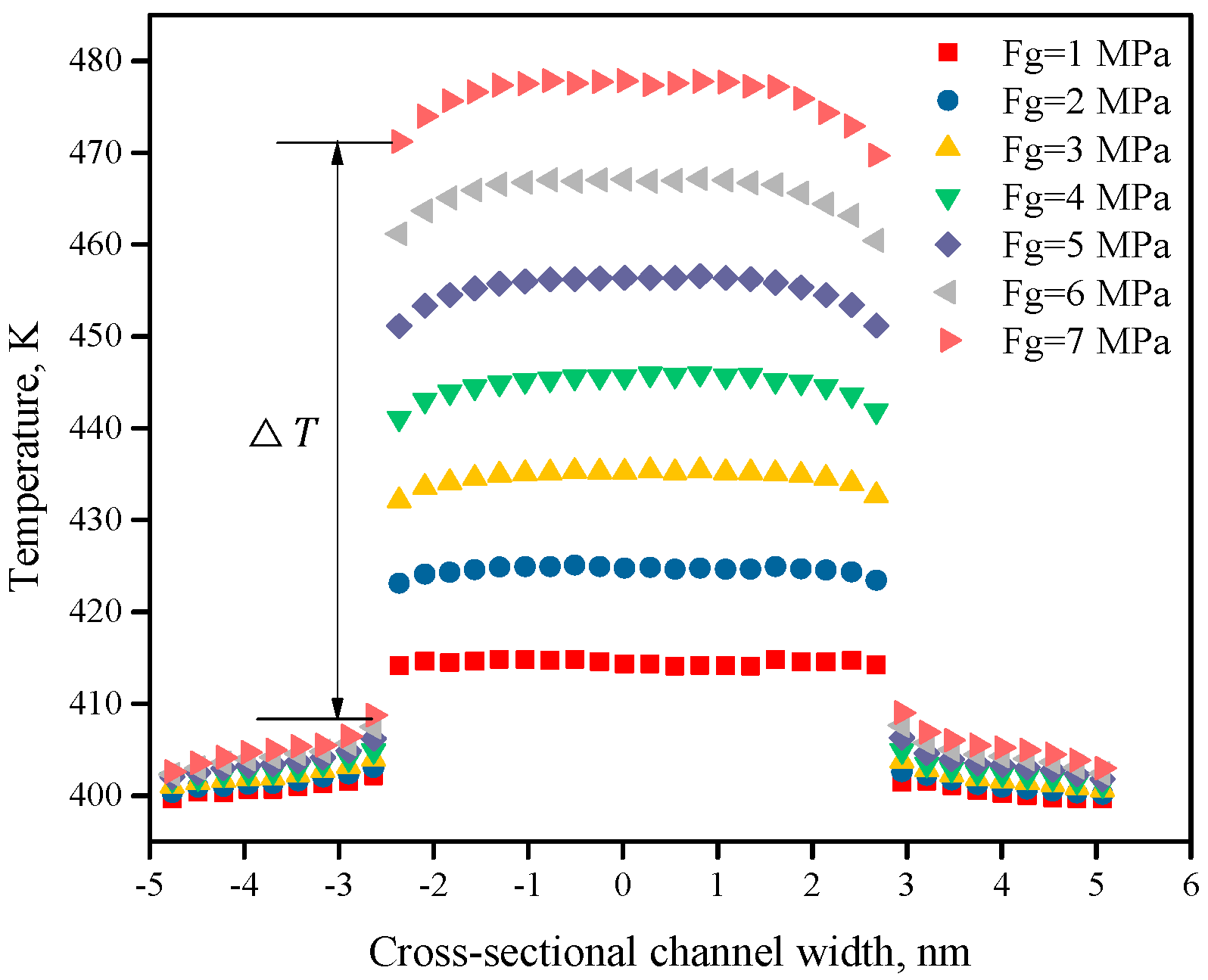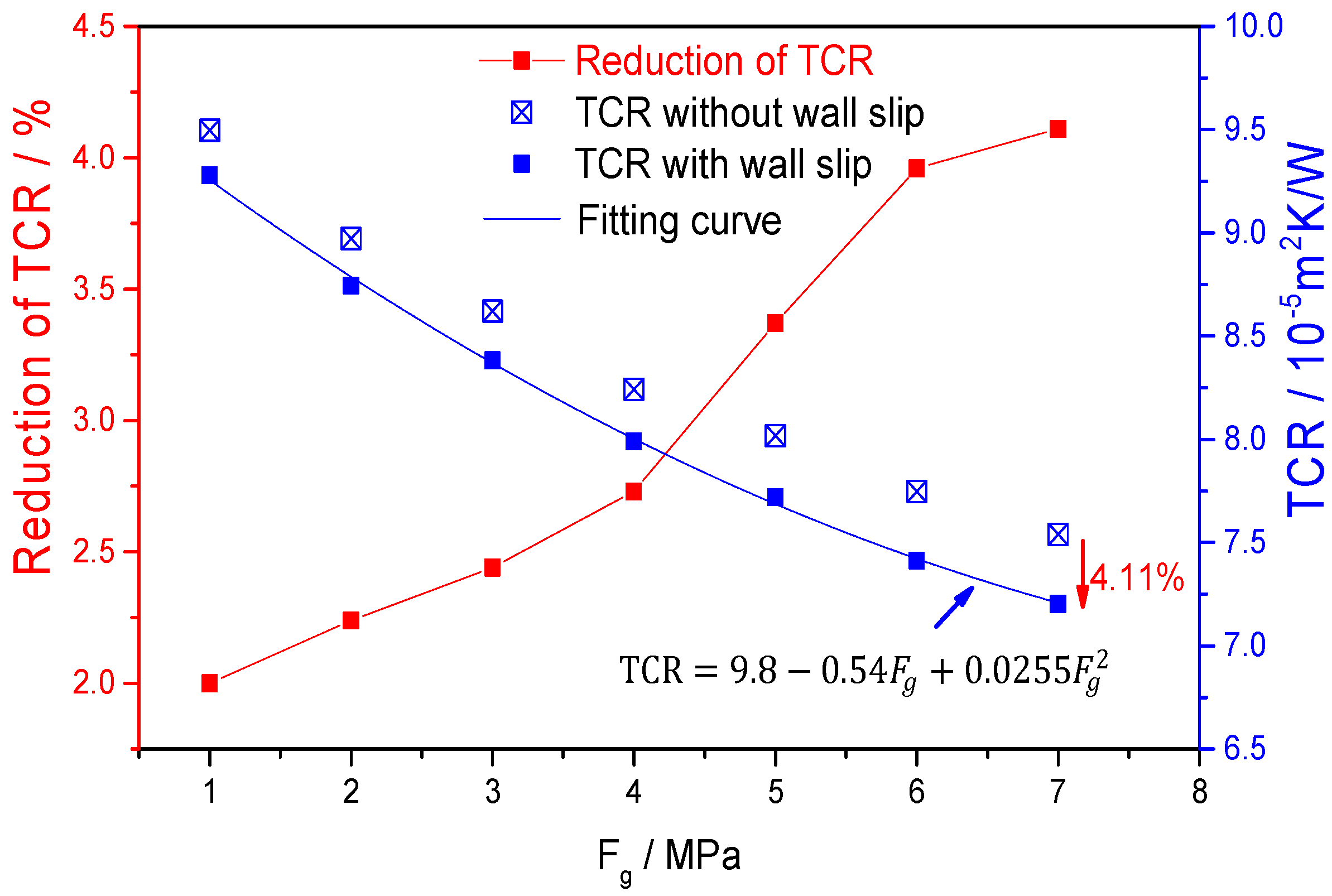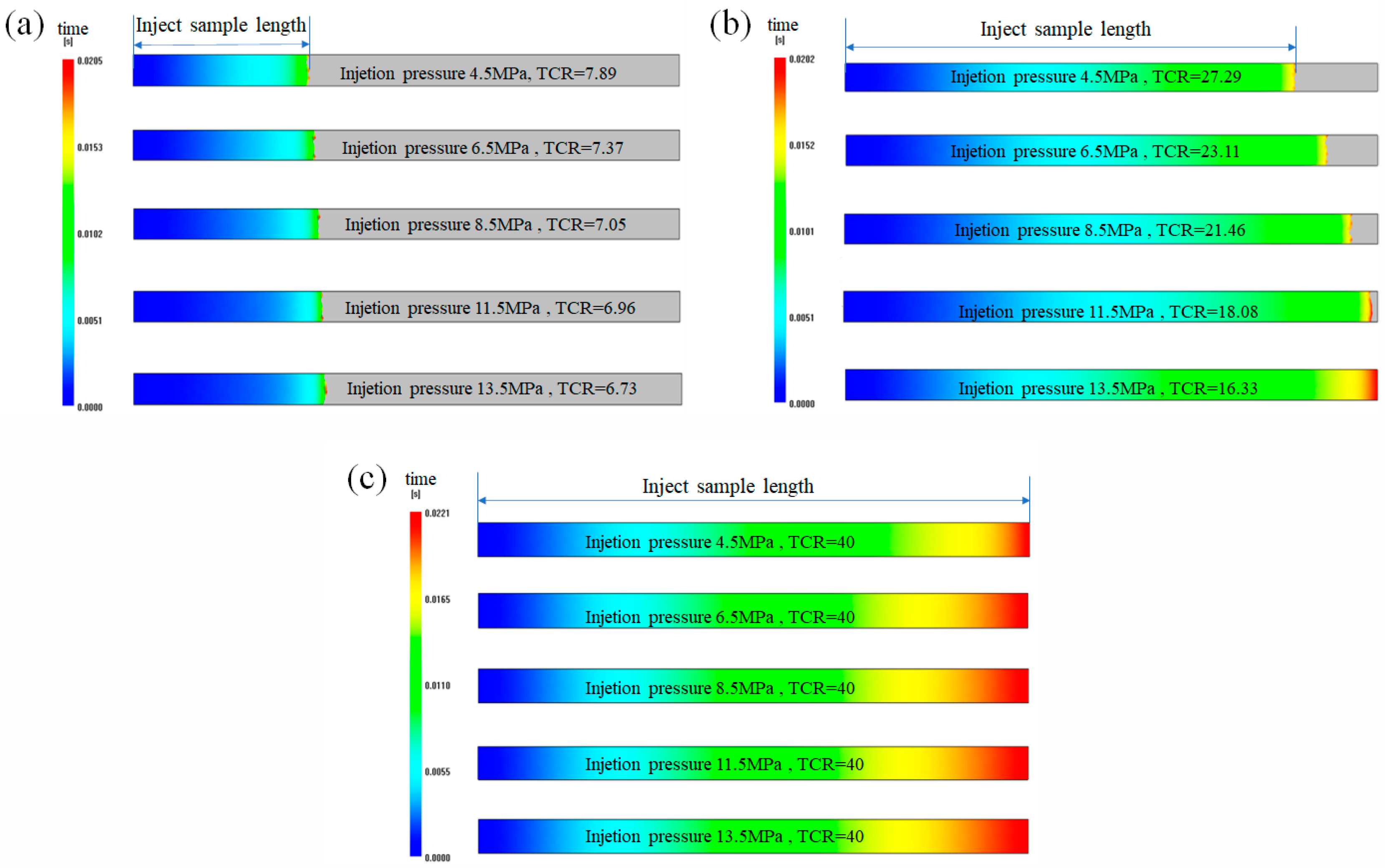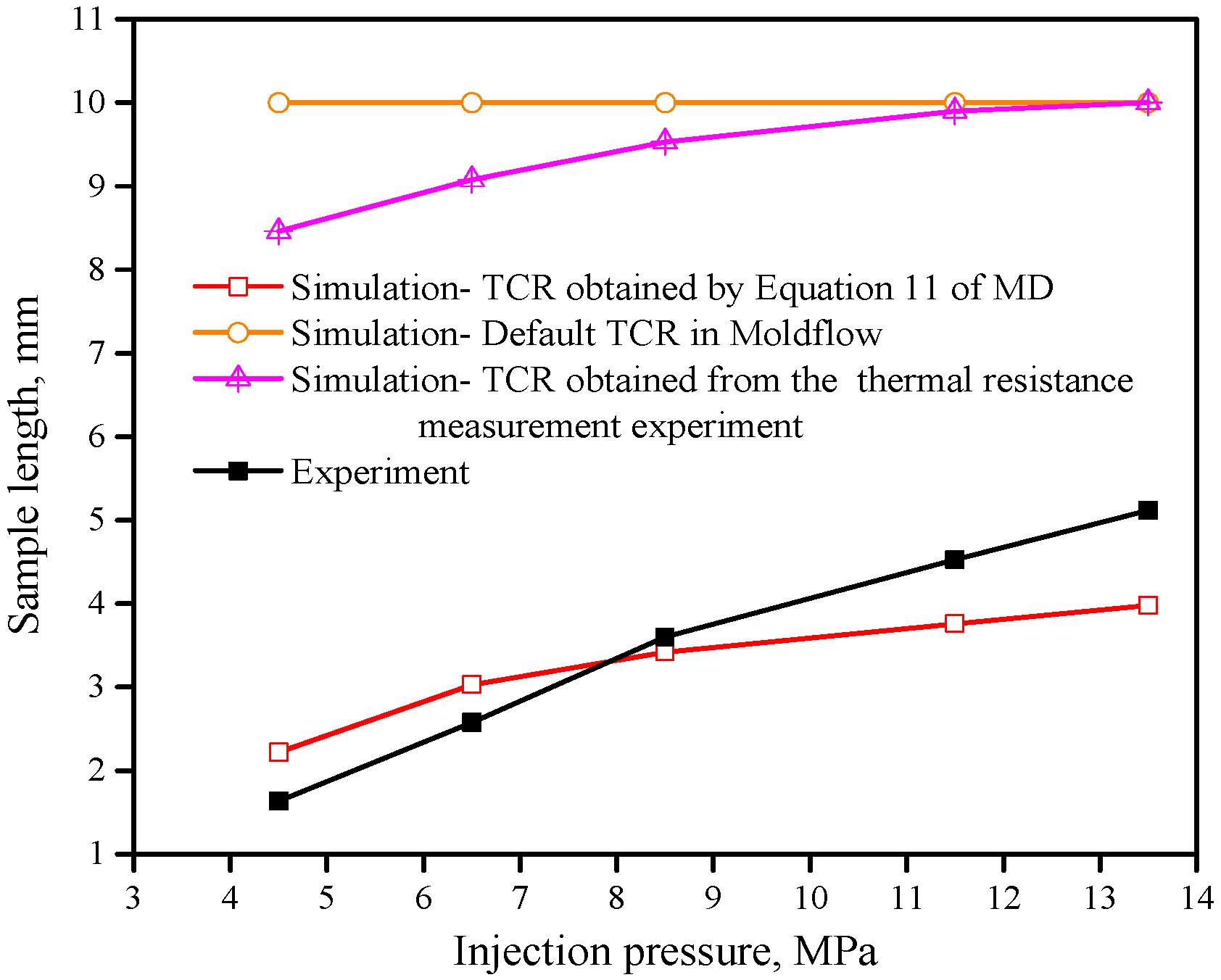1. Introduction
Micro/nano-injection moulding increases the surface-to-body ratio of micro/nanoscale cavities, which intensifies the heat transfer at the solid–liquid interface and leads to rapid cooling of a melt. Wall slip and thermal contact resistance (TCR) are important boundary parameters in numerical simulations, and they determine the accuracy of micro/nano-injection moulding simulations.
Many scholars have begun to use molecular dynamics (MD) simulations to study the wall slip phenomenon. For example, Martini et al. [
1] used MD to simulate the wall slip length and found that there is a threshold at a higher shear rate; the slip length does not change after exceeding this value. Bendada et al. [
2] reported that in the early stage of injection moulding, polymer macromolecular chains produced tensile orientation deformation under the action of flow-induced stress. In the later stage of mould filling, as the orientation deformation time was prolonged, the molecular chains unwrapped due to the orientation deformation time. The knots tended to be dispersed. At the same time, it is considered that there is a stress threshold. When the stress is greater than this value, the molecules loosen, and untangling occurs. Sridhar [
3] used MD to simulate the injection process of polymethyl methacrylate (PMMA) nanopillars and found that PMMA molecules stretched along the sidewalls and were highly oriented along the flow direction.
Second, the interface TCR is mainly obtained through experiments and theoretical derivation. Hong et al. [
4] calculated the TCR through recursive methods based on indirectly measuring the filling height of patterns as a function of time, and estimated the changes in the TCR with time and position. Dawson et al. [
5] experimentally determined that the maximum heat transfer coefficient between the melt of PMMA material and the surface of the cavity is 7000 W/m
2 K and introduced the concept of an air layer; that is, after the melt is filled, cooled and allowed to contract, there is an air layer between the wall and the plastic part in the cavity. The interface heat transfer coefficient (HTC; the reciprocal of the TCR) in the presence of the air layer was studied, and a relevant model was established. Some et al. [
6] established a rough interface TCR model that simultaneously correlates pressure and temperature and found that the model can reliably predict TCR even during polymer crystallisation at the contact interface. Liu et al. [
7] focused on evaluating the HTC between the polymer and the cavity wall and established a mathematical model to improve the simulation of cooling and crystallinity development, thereby improving the accuracy of injection moulding simulations to predict the mechanical properties and dimensional accuracy of injection-moulded parts. Zhou et al. [
8] analysed the relationship between TCR and cooling time by developing a three-dimensional transient cooling analysis module for injection moulds, and they constructed a TCR calculation model. Wang et al. [
9] found that during rapid thermal cycle formation, the heat transfer coefficient increased sharply in the initial stage, gradually decreased and finally reached the equilibrium state; the larger the Reynolds number is, the higher the heat transfer coefficient.
However, few scholars have performed studies to simulate the TCR of polymer walls based on MD. He [
10] and Arduini-Schuster et al. [
11] conducted MD simulations of the heat transfer of aerogel and foam microstructures, respectively, but only studied the heat transfer rules without external pressure. Song et al. [
12] used MD simulations to study the effect of wall slip on the interface thermal resistance for liquid argon and found that the wall slip at low flow rates had no significant effect on the interface thermal resistance, while the wall slip at high flow rates would cause the interface thermal resistance to be reduced by approximately 10%; however, the simulations only involved a liquid with a simple molecular chain and did not consider a polymer macromolecular chain.
In this study, the Poiseuille flow of a molten polymer between parallel plates was used as the research object and PMMA was used as the research material. According to the Navier slip law, an all-atom analysis model of polymer macromolecules is established. By studying the effect of wall wettability and external driving pressure on the wall slip behaviour of polymer macromolecules and the spatial evolution process of the entanglement–unentanglement of the polymer chain near the wall under different shearing effects, the interface thermal resistance rule at the micro/nanoscale was elucidated. The influence of wall slip on the heat conduction under plastic processing pressure of polymer was also revealed, and the interface thermal resistance model considering the wall slip was established. The effectiveness and accuracy of the model were verified by micro-injection experiments. The difference between simulation results and experimental measurements was due to the wall surface being set to an ideal smooth state in the simulation process. In the following work, a nanoscale fractal rough surface model is established using fractal theory and molecular dynamics, to obtain more accurate simulation results.
2. PMMA Polymer Molecular Dynamics Model
2.1. Model Construction
The polymer molecular dynamics model is constructed with Materials Studio (2017 edition, Accelrys Software Inc., San Diego, CA, USA) and the open source molecular dynamics calculation program LAMMPS (Large-scale Atomic/Molecular Massively Parallel Simulator) [
13]. The simulation calculation platform is a Dell 7820 graphics workstation with 2.2 GHz CPU frequency (Dell Computer Corporation, Austin, Texas, USA). The model is mainly composed of a molten polymer and a metal mould.
First, the body-centred cubic unit cell of the iron mould material is established as shown in
Figure 1a, where the red part represents the crystal structure of iron, and the blue plate represents the supercell structure obtained by modelling based on the crystal structure of iron (red part). Second, according to the structural characteristics of PMMA materials, the required molecular structure is established by the visualiser function in Materials Studio. Because of the differences in polymerisation mechanisms, PMMA has three different structural manifestations: isotactic, syndiotactic and atactic. In practical industrial applications, isotactic PMMA is widely used, so isotactic PMMA is used as the initial monomer structure (
Figure 1b). Finally, using this structural monomer as the smallest repeating unit, a single-chain polymer structure with a degree of polymerisation (DP) of 100 is established by the build module in Materials Studio. Then, the amorphous cell tool is used to build an amorphous polymer system with 20 single chains of the PMMA polymer with a DP of 100, as shown in
Figure 1b.
To obtain a reasonable and stable initial conformation, it is necessary to optimise the structure and minimise the energy to obtain a stable single-chain polymer. The initial temperature of the polymer is set to 300 K, the density is 1.18 g/cm
3, the size of the simulated system is 10 nm × 10 nm × 10 nm, and the channel width of the polymer melt region is 5 nm. The configuration parameters of the PMMA polymer system are shown in
Table 1.
The system performs 103 iterations by the Forcite dynamics calculation module in Materials Studio, and the energy convergence level is set to 1 × 10−5 kcal/mol. The smart method was used to optimise the geometric structure. Then, the energy is relaxed by an annealing treatment, and the annealing simulation is performed for 5 cycles by the anneal function in the Forcite module so that the energy of the system is stable. There is a total of 5 cycle periods, and a single cycle gradient is 50 K. The temperature change range is 200 to 500 K, and a single cycle gradient is calculated at 1000 steps. A total of 5 × 105 steps are calculated at the end of 5 cycle periods.
Figure 2 shows the system temperature and energy changes during the entire annealing calculation. After five annealing simulation calculations, the system energy is reduced from 7300 kcal/mol to approximately 3000 kcal/mol and stabilised. The five annealing cycles were used to calculate the energy that can balance the amorphous system. After the annealing calculation is completed, a total of five trajectories are obtained, and the fifth frame trajectory is extracted as the initial conformation for the next polymer flow calculation.
The PMMA material architecture obtained after geometric optimisation and energy minimisation must also be subject to relaxation treatment.
Figure 3 shows the temperature and energy change curves during relaxation. It can be clearly seen that after a 100 ps relaxation treatment, the fluctuation range of the temperature is within ±10 K (
Figure 3a), and the energy fluctuation is within 5% (
Figure 3b), indicating that the polymer is at equilibrium at this time.
2.2. Pressure Parameter Setting
The upper and lower plates are fixed in the calculation process, and the polymer melt in the middle is affected by the
(
Figure 4). There are two main sources of force in the polymer chain: one is the force exerted by the external pressure
, and the other is the force
between the particles of the polymer chain itself and the
potential.
Then, the force acting on the polymer monomer is
where
is the force exerted by the external pressure,
is the interaction force between polymer monomers,
is the potential energy function between monomers,
is the position vector between monomers
and
,
is the potential function of monomer
and wall
and
is the position vector of single
and wall
.
The interaction force between polymer monomers is calculated as , where , is the elastic modulus, is the unit length and is the maximum elongation of the monomer polymer chain.
For Poiseuille fluid flow, under the action of external pressure , there are two effects: (a) driving fluid flow and (b) conversion into heat, which increases the temperature of the fluid. In the simulation calculation process, the temperature must be controlled to prevent an unrestricted increase in the fluid temperature, so the wall temperature control method is used in this study.
2.3. Model Layered Statistics
The model of polymer fluid flow between parallel plates generally stratifies the entire
y-axis direction of the fluid into Y layers and creates a function of
,
where
represents the position of the particle
at the
th step. Then, Equations (3)–(5) can be used to calculate the density
, velocity
and temperature
of the single-layer particles.
3. Experiments
3.1. Experiment to Measure the Interface TCR
To obtain the TCR value between the solid–liquid interface, it is necessary to measure the mould surface temperature and the melt temperature. The heat flux density through the interface is calculated by the temperature recorded by the thermocouple. The platform to measure the interface TCR includes a micro-injection moulding machine (Babyplast 6/10, Rambaldi Group, Montoro, Italy), an injection mould (homemade), a thermocouple (TT-K-36-SLE, Omega Engineering Inc., Norwalk, CT, USA) and a real-time data acquisition system (NI USB-9162, National Instruments, Austin, TX, USA).
The mould core contains inserted blocks to install the temperature sensor, and the installation position of the temperature sensor in the mould core is shown in
Figure 5. Two thermocouples were placed at the same time by drilling holes in the mould core. The installation positions of the two thermocouples are parallel to each other inside the mould core and are perpendicular to the mould parting surface. The distances from the lower surface of the microstructure cavity are 0.50 and 1.00 mm. The sensors are connected to the data acquisition card, which can measure the real-time internal temperature of the mould during the micro-injection moulding process. For reliable results, under each set of process parameters, the temperature was measured repeatedly 5 times, and then the average value was taken for analysis and calculation.
According to heat transfer theory, during the micro-injection moulding process, the high-temperature melt enters the mould cavity under the action of a certain injection pressure, and the heat is first transferred to the mould cavity wall surface and then transferred to the mould through the solid–liquid interface. Finally, the heat diffuses into the air. Therefore, it can be approximated that the heat flux interacting between the polymer and the wall surface is equal to the heat flux flowing through the mould. The temperature of the wall can be measured by the sensor to obtain the heat flux in the mould.
According to Newton’s law of cooling, the heat flux density
, that is, the amount of heat passing through a unit area per unit time, can be expressed by Equation (6),
where
is the heat flux density in the mould,
is the mould material thermal conductivity,
T1 and
T2 are the temperatures measured by two temperature sensors at different positions and
is the distance between two temperature sensors in the thickness direction of the cavity.
Newton’s cooling law (Equation (7)) is used to calculate the heat transfer performance at the solid–liquid interface:
where
is the heat flux density of the molten polymer to the cavity wall,
is the heat transfer coefficient between the molten polymer and the cavity wall,
is the temperature of the polymer melt and
is the temperature of the cavity wall.
The temperature of the cavity wall can be expressed by Equation (8).
For
, the expression for calculating the convective heat transfer coefficient (Equation (9)) can be obtained:
Then, the equation for the interface TCR (Equation (10)) is obtained.
3.2. Micro-Injection Moulding Experiments
Micro-injection moulding is performed using a micro-precision injection moulding machine (Babyplast 6/10, Rambaldi Group, Montoro, Italy). Its plunger diameter is 10 mm, the maximum clamping force per unit area is 15 MPa, the maximum injection volume is 15 mL, the total power is 3 kW, the maximum injection pressure is 15 MPa and the maximum injection speed is 80 mm/s.
PMMA material (IG-840, LG Group, Seoul, Korea) is used, and its basic properties are a thermal conductivity of 0.123 W/(m2 k), a specific heat capacity of 1717 kJ/(kg·°C), a melting point of 240 °C and a density of 1.0606 g/cm3. The length × width × thickness of the injection sample is 10 mm × 0.4 mm × 0.1 mm.
During the experiment, the injection pressure was set to 4.5, 6.5, 8.5, 11.5 and 13.5 MPa; the injection speed was 55 mm/s; and the injection temperature was 250 °C. To obtain a more accurate sample length, 5 samples were selected under each group of parameters in this study for averaging the data.
3.3. Finite Element Simulation of Micro-Injection Moulding
The finite element simulation uses Moldflow software (2017 edition, Autodesk Inc., San Rafael, CA, USA), and the injection moulding materials and process parameters are consistent with the actual injection experiments in
Section 3.2. In the simulation, the double-layer mesh type is selected for mesh division, and the total number of meshes is 45,305. To compare the effectiveness of the interface TCR obtained by various methods, the interface TCR used in the simulation was selected based on the TCR value from the MD simulation, the default TCR value in Moldflow software, and the experimental TCR value from the interface thermal resistance measurement.


